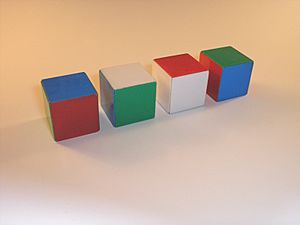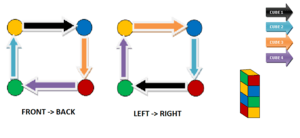Instant Insanity facts for kids
Instant Insanity is a famous puzzle that was made popular by Parker Brothers in 1967. But this type of puzzle has actually been around for a very long time! Many different toy companies have sold it under various names like Devil's Dice, DamBlocks, and Logi-Qubes.
The puzzle comes with four cubes. Each side of these cubes is colored with one of four colors, usually red, blue, green, and white. The goal is to stack these four cubes into a single column. When you finish, each of the four sides of the stack (front, back, left, and right) must show all four different colors. Each cube has its own unique way that the colors are placed on its faces.
Contents
How Hard Is It to Solve?
Trying to solve Instant Insanity by just guessing and moving the cubes around is very difficult. There are a huge number of ways you can arrange the four cubes! Imagine trying to find the right setup out of 331,776 possible arrangements. That's why it's called "Instant Insanity"! Luckily, once you know the trick, any position of the puzzle can be solved in eight moves or less.
A Look at the Puzzle's History
The very first known version of this puzzle was patented in 1900 by Frederick A. Schossow. He called it the Katzenjammer puzzle. Later, in 1967, Franz Owen Armbruster recreated the puzzle. It was then released by both Parker Brothers and Pressman. Parker Brothers alone sold more than 12 million of these puzzles! Before "Instant Insanity" became popular, a similar puzzle from around 1940 was known as The Great Tantalizer. Today, you can still find a version of the puzzle sold by Winning Moves Games USA.
How to Solve Instant Insanity
Solving Instant Insanity isn't about random guessing. It's about understanding how the colors are arranged on each cube and making sure all four colors appear on each side of the stack.
To solve the puzzle, you need to think about the colors on opposite sides of each cube. For example, if a cube has red on one side, what color is directly opposite it?
Imagine you have two special "maps" for the cubes:
- One map helps you figure out which colors go on the front and back of each cube.
- The other map helps you figure out which colors go on the left and right sides of each cube.
What are the rules for these "maps"? You can't just pick any colors for your maps. Here are the important rules:
- No shared colors: The colors chosen for the front/back of a cube cannot be the same as the colors chosen for the left/right of that same cube. Each pair of opposite faces must be unique.
- All cubes included: Each "map" must include one pair of opposite colors from every single cube.
- Even color distribution: Each color (red, green, blue, white) must appear exactly twice across all the faces chosen for a map. This makes sure that when you stack the cubes, each color shows up once on each side of the stack.
Once you follow these rules, you can find the correct arrangement. Look at the image below to see how the solution comes together.
From the first part of the image (the top diagram), you can figure out the front and back colors for each cube:
- The black arrow from White to Blue means the first cube will have White on its front and Blue on its back.
- The blue arrow from Green to White means the second cube will have Green on its front and White on its back.
- The orange arrow from Blue to Red means the third cube will have Blue on its front and Red on its back.
- The purple arrow from Red to Green means the fourth cube will have Red on its front and Green on its back.
From the second part of the image (the middle diagram), you can figure out the left and right colors for each cube:
- The black arrow from Red to Green means the first cube will have Red on its left and Green on its right.
- The blue arrow from Blue to Red means the second cube will have Blue on its left and Red on its right.
- The orange arrow from Yellow to Blue means the third cube will have White on its left and Blue on its right.
- The purple arrow from Green to White means the fourth cube will have Green on its left and White on its right.
The third image (bottom diagram) shows the final stack of cubes, which is the solution to the puzzle!
It's good to remember a few things:
- Once you find one solution, there are many others! You can swap the order of the cubes in the stack without changing how each cube is turned.
- The "front/back" and "left/right" maps can be swapped. If you find a solution for front/back, you can also use it for left/right, and vice versa.
- The colors on the very top and bottom of the stack don't matter for solving the puzzle, only the four sides.
Images for kids






